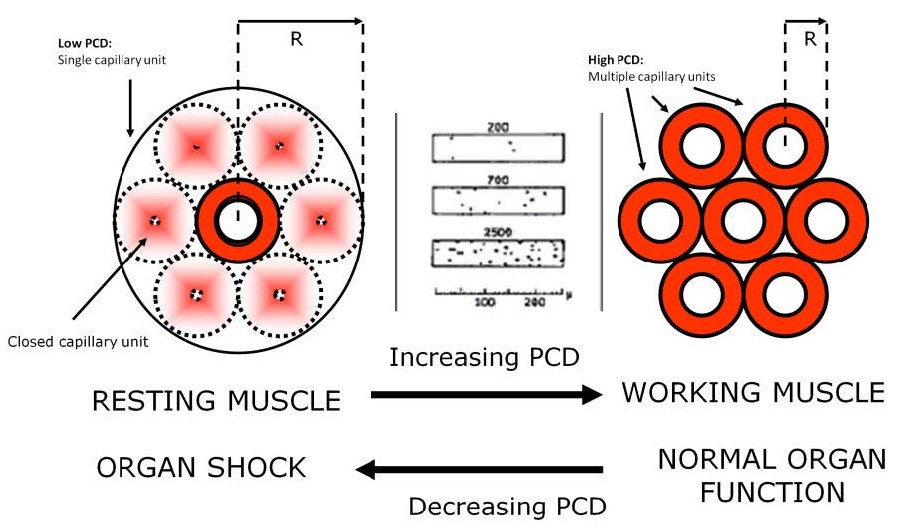
Perfused capillary density changes as the metabolic demands change. Failure to increase PCD during times of stress is pathologic and may be associated with the health state of the patient.
In resting tissues the number of open capillaries is relatively small because the need for oxygen delivery and carbon dioxide removal is relatively small. However if the tissues begin working or consuming greater amounts of oxygen, the number of open capillaries normally increases. As additional capillaries open, smaller and shallower Krogh cylinders form resulting in much more efficient oxygen delivery and carbon dioxide removal to meet the increased metabolic need. The number of open capillaries within a specific volume of tissue is called perfused capillary density (PCD). PCD normally changes as the metabolic need changes, increasing as metabolic need increases and decreasing as metabolic need decreases, such as when muscles start or stop working.
The body’s ability to open and close capillaries is the key to maintaining homeostasis in any type of tissue without excessive utilization of physiologic resources. When the need for oxygen is diminished there are fewer open capillaries and the Krogh cylinder is relatively large and deep. When oxygen need is increased cardiac output increases and more capillaries open. The Krogh cylinder becomes smaller and shallower and more efficient at distributing oxygen to the mitochondria. However during illness additional needed capillaries may fail to open and some open capillaries may close, resulting in a decrease in PCD. This phenomenon has many etiologies such as cardiac failure, blood loss, infection, spinal nerve damage, etc. However, they are all grouped under a common diagnosis called “shock”.
Shock occurs when the body fails to open an adequate number of capillaries to supply oxygen and remove carbon dioxide; i.e., PCD is inadequate to support life. So in OPFT terms, shock is simply inadequate PCD. Frequently shock is defined as inadequate cardiac output or inadequate oxygen delivery. However shock can occur even if cardiac output and oxygenation seem normal. This is because PCD in vital organs cannot be quantified clinically using the customary assessments. When poor PCD occurs the condition is termed a ‘lethal corner’.

Perfusion Theory is an educational platform for the Oxygen Pressure Field Theory (OPFT). August Krogh’s theoretical concept of the oxygen pressure field is explained and then applied to clinical applications in perfusion practice.